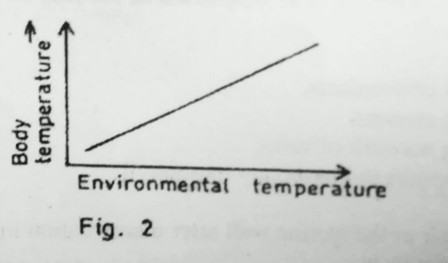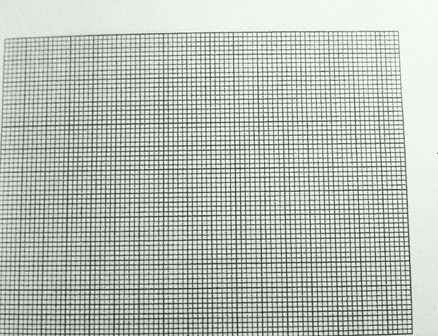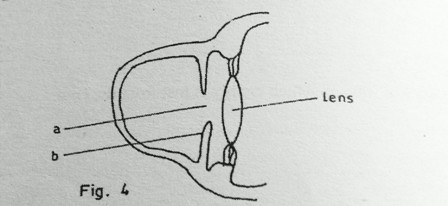SECTION A
Answer all questions in this section. Write the letter representing the most correct answer to each question, in the box provided.
1. Which one of the following control measures against mosquitoes is least harmful to the environment?
A. Draining of swamps.
B. Spraying with insecticide.
C. Covering surfaces of stagnant water with oil.
D. Introducing fish in ponds.
2. The magnification of a biological drawing is given as x0.5. this means that the drawing is
A. Five times larger than the specimen.
B. Half natural size of the specimen.
C. Twice the natural size of the specimen.
D. Five times smaller than the specimen.
3. A diet most suitable for strengthening of teeth and bones should be rich in
A. Iodine and vitamin K.
B. Calcium and vitamin D.
C. Magnesium and vitamin C.
D. Iron and vitamin B.
4. Which one of the following digestive processes is catalyzed by salivary amylase?
A. Maltose to glucose.
B. Sucrose to glucose and fructose.
C. Starch to maltose.
D. Lactose to Galactose and glucose.
5. Figure 1. Show the effect of relative humidity on transpiration rate.
IMAGE
From the figure, transpiration rate
A. Increase with decreased relative humidity.
B. Increases with increased relative humidity.
C. Decreases with decreased relative humidity
D. Remains constant with increased relative humidity.
6. Which one of the following classes has the highest number of species?
A. Crustacean.
B. Arachnida.
C. Insect.
D. Myriapoda.
7. Which of the following substances is not contained in the glomerular filtrate in the mammalian kidney?
A. Urea.
B. Plasma proteins.
C. Glucose.
D. Mineral salts.
8. Which one of the following is an adaptation of the leaf for transportation of manufactured food?
A. Numerous chloroplasts.
B. Numerous stomata.
C. Branching network of veins.
D. Large airspaces in the spongy mesophyll.
9. Slow rate of repair of the uterine wall after menstruation in a mammal may be due to a deficiency in
A. Oestrogen.
B. Luteinizing hormone.
C. Progesterone.
D. Follicle stimulating hormone.
10. Which of the following vertebrae provide points of attachment to the ribs?
A. Cervical.
B. Thoracic.
C. Lumbar.
D. Sacral.
11. Which of the following allow smooth movement of borne at a join?
A. Synovial fluid.
B. Tendons.
C. Ligaments.
D. Synovial membrane.
12. Clay soil has high water retention capacity because it
A. Has small air space.
B. Contains little amount of humus.
C. Is sticky when wet.
D. Has good capillary attraction.
13. Which of the following is the correct order of cell organization?
A. Cell - organ - tissue - system.
B. Tissue - cell - organ - system.
C. Organ - cell - tissue - system.
D. Cell - tissue - organ - system.
14. Figure 2. Show changes in the body temperature with environmental temperature in an animal.

Which one of the following could be the animal represented?
A. Bird.
B. Dog.
C. Human.
D. Frog.
15. Which of the following groups of organisms usually colonise bare rock fire?
A. Herbs.
B. Mosses.
C. Lichens.
D. Grasses.
16. Which of the following features differentiate a housefly a housefly from a spider?
A. Segmented body.
B. Jointed limbs.
C. Number of body parts.
D. Possession of exoskeleton.
17. Which one of the following relationships in an example of mutualism?
A. Tapeworm living in a human gut.
B. Bacteria living in the gut of a cow.
C. Ticks living on the skin of a dog.
D. Plasmodium living in human blood.
18. Which one of the following plant organs can be used in vegetative reproduction?
A. Stem tuber of Irish potato.
B. Root tuber of cassava.
C. Tap root of a carrot.
D. Leaves of an onion.
19. The following are responses to cold conditions in mammals:
1) Vasoconstriction.
2) Hair standing up.
3) Shivering.
4) Increase in metabolic rate.
Which of these, both reduce heat loss?
A. 1 and 2
B. 1 and 4
C. 2 and 3
D. 3 and 4
20. Which of the following are not respiratory surfaces in animals?
A. Spiracles.
B. Trachioles.
C. Gill filaments.
D. Alveoli
21. A man of blood group AB marries a woman of blood group O. what would be the possible blood groups of their children?
A. O and AB.
B. A only.
C. AB.
D. A and B.
22. Which one of the following types of fruits is a pineapple?
A. Drupe
B. Multiple fruit
C. Indehiscent fruit
D. Berry
23. Strips W, X, Y and Z of same size and shape were cut from a raw pawpaw, whose sap had a sugar concentration of 28%. The strips were then placed in sugar solution of different concentrations as shown in table 1.
|
Strip |
Sugar concentration of solution (%) |
|
W |
15 |
|
X
|
25 |
|
Y
|
28.5 |
|
Z
|
48 |
Which strip would be longest after 4 hours?
A. X
B. W
C. Y
D. Z
24. What is likely to happen if a maize coleopitile whose tip has been removed, is illuminated from from only one side? The coleoptiles would
A. Curve towards the direction of light.
B. Curve away from the direction of light.
C. Not show any further growth.
D. Grow upright.
25. Which of the following sets of joints consists of only the hinge type?
A. Hip, wrist and elbow.
B. Neck, shoulder and elbow.
C. Elbow, knee and finger joints.
D. Knee, wrist and ankle.
26. Which one of the following is the least important reason why plants need to ensure efficient dispersal of seeds in nature?
A. Increasing chances of finding a better habitat for multiplication.
B. Escape being eaten by animals in its original habitat.
C. Reducing competition for food.
D. Ensuring better colonization of different places.
27. Under which of the following sets of conditions indicated in table 2 will been seeds germinate?
|
Temperature |
Light |
Water |
Oxygen |
|
|
A |
20⁰C |
Absent |
Present |
Present |
|
B |
20⁰C |
Present |
Absent |
Present |
|
C |
0⁰C |
Present |
Present |
Present |
|
D |
20⁰C |
Present |
Present |
absent |
28.
29. In plants, large surfaces area to volume ratio for gaseous exchange is achieved by
A. Presence of numerous stomata on leaves.
B. Flatness of leaves.
C. Presences of air spaces in the mesophyll.
D. Presence of lenticels.
30. In the mammalian heart, the thick muscular walls of the left ventricle are vital for
A. Resisting pressure of the blood coming into the ventricle.
B. Maintaining the shape of the heart.
C. Producing enough pressure to pump blood to all parts of the body.
D. Resisting back flow of blood from the aorta.
SECTION B
Answer all questions in this section. Answers must be written in the spaces provided.
31. Table 3. Shows the change in mass of starch and protein in a typical pea seed during the first 20 days of germination.
TABLE 3
a) Using the same axes, draw two graphs to show the change in mass of starch and protein during the first 20 days of germination of the seed, in the space provided.

b) How are the changes in mass of starch and protein
(i) Similar?
(ii) Different?
c) Explain why the mass of starch and proteins change in the germinating seed. In each case state the reactions that result into the changes.
d) Suggest two ways in which the products from each of starch and proteins may be used in the germinating seed.
(i) Starch
(ii) Proteins
32. In a food chain, when energy is transferred from one atrophic level to another, some of it is lost. Figure 3. Shows such a transfer of energy in and out of a cow in year.

a) Name the atrophic levels shown in the figure.
b) State two ways in which energy is lost from the cow.
c) Calculate the percentage of energy taken in during the year, which is retained by the cow.
d) In proportion to its body, a calf uses more energy to maintain its body temperature than a cow. Explain why this is so.
e) In the recycling of materials, how can the energy within the cow be made available to plants?
33. Figure 4. Shows part of a section of a human eye.

a) Name the parts labelled a and b.
a...........................................................................................................
b...........................................................................................................
b) What is the function of structure b in the eye?
c) If a person entered a room with bright light, state the changes that would occur in each of parts a and b of the eye.
(i) a..............................................................................................
(ii) b..............................................................................................
d) In the space below, draw the shape of the lens only, when the eye is focusing on a near and distant object respectively.
When focusing on a When focusing on a distant near object
object
e) Describe how the shape of the lens is brought when the eye is focusing on a near object.
SECTION C
Answer any two questions.
34. a) Describe the breathing mechanism in a bony fish.
b) How are gills in a bony fish adapted to their functions?
35. a) Outline the internal structural differences between monocotyledonous and dicotyledonous plants in the following parts:
(i) Stems.
(ii) Roots.
b) Describe how leaves of green plants are suited for photosynthesis.
36. a) Explain how the small sizes of soil particles in a soil type affect the soil's suitability for plant growth.
b) Describe an experiment to compare the rate of drainage of two soil samples.
37. a) What is meant by pollution?
b) Explain how continued use of polythene paper may harm the environment.
c) Suggest ways of preventing the effects suggested in (b).
